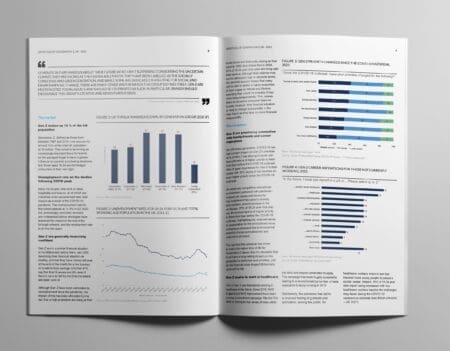Globalization – an exploration of how banks across the globe are developing and utilizing new technology to expand their reach, service their customers and improve transactions across borders was one of the themes at Money20/20 on day one.
The morning kicked off with a “fireside chat” with some of APAC’s key FinTech players. Eagle Yi of WeChat Pay emphasized the multitude of tasks that its one billion users can complete within the app – reading the news, interacting with colleagues, making payments, online shopping, etc. Twenty thousand US stores now accept WeChat, providing a familiar payment option for tourists. Also expanding into US retailers is AliPay, with over 175,000 US merchants signed up, while their core focus is on Chinese users and an ambitious goal to grow their base to two billion by 2026. Their mission is to provide access globally for the underserved in developing countries and also promoting AliPay as a “financially inclusive lifestyle app.” Ant Financial (parent company of Alipay) CCO classified the company as a “TechFin” rather than a FinTech, putting it in a category of established technology companies that are expanding into financial services.
Origami Pay also has grand initiatives, including helping Japan become a cashless society. The government’s goal is to become 40% cashless by 2025, and eventually reach 80%, a bold vision for a traditionally cash-centric culture. Like its Chinese counterparts, Origami Pay uses QR codes to transact payments, and offers promotions and discounts to drive adoption. While once the de-facto standard, Arthur Zhu of China’s merchant-based LianLian Pay argued that QR codes are not a key driver, rather it was a necessity of technology needing to access a mobile wallet. Zhu predicts that QR codes will not see widespread adoption in more established financial ecosystems like the US.
The protection and privilege of identity
Other major topics revolved around digital identity, biometrics, and blockchain technology. When discussing authentication, creating a balance between security and convenience is key. When asked what was more important when conducting payment transactions, only 48% of the Money20/20 audience chose security. When the question was altered to ask about banking transactions, the figure rose to 72%. Todd Mozer, CEO of biometric firm Sensory, added that privacy needed to be added to the mix.
Allen Ganz of NEC described scenarios where users would have full control over their biometric data, choosing when and for how long to release it. Nevertheless, biometrics does seem to be the future of authentication, with Allen predicting that behavioral analysis will advance and “facial recognition will be ubiquitous.”
Shyft CEO, Bruce Silcoff, continued the identity conversation by asking, “Is blockchain the future of digital identity?” Silcoff stated that with all of the data breaches occurring daily, it is not a question of whether one’s identity has been compromised, but rather if anyone has done anything with the information. Shyft wants to use blockchain technology to reduce the amount of locations where personal data is stored while maintaining global standards, creating a “centralized, de-centralized solution.” Civic CEO, Vinny Lingham also wants to eliminate the possibility of hackers accessing large piles of PII. He claimed that “getting rid of usernames and passwords is the first step.” In their place, Civic would run in the background, providing seamless authentication through blockchain technology. “If we have to talk about blockchain to the consumer then we’ve lost.”
Ultimately, the discussion shifted from narrow usage within financial services to a more humanitarian vision of securing identification globally. Silcoff pointed out that 1.1 billion people do not have a legal ID and miss out on numerous benefits, essentially making identification a privilege rather than a right. In the end, both Silcoff and Lingham agreed that if blockchain technology catches on, the biggest winner needs to be the individual.
Artificial Intelligence: From command technology to anticipating consumer needs
Concluding the day was Sofia Altuna of Google, Ken Dodelin of Capital One, Peggy Mangot of Wells Fargo and David Sosna of Peronetics participating in a fascinating discussion of artificial intelligence (AI). Sofia spoke of the success of Google Assistant, how conversation drives consumer engagement and Google’s current focus on multilingual recognition and moving beyond voice to create a multimodal digital interaction. Dodelin focused on Capital One’s virtual assistant Eno and the need to make sure that when designing AI, machines are made to act like humans, not the other way around. In his example, instead of limiting customers to two or three responses within an automated system, Eno can recognize normal conversation and emojis. In fact, more than 60% of customers choose an emoji to confirm payments in app, as opposed to text.
Mangot took things a step further, stressing the need for AI to truly serve the needs of the customer. She argued that the tide was shifting from Personal Financial Management (PFM) tools, which simply show payments and budgeting options to a Personal Financial Coach (PFC). AI needs to deliver a personalized experience, anticipating customer needs and making recommendations in real time to assist on a path to financial health. According to Mangot, all needs can be effectively met by shifting from a product-based model to customer-centric.
What we think
Key takeaways from day one are emphasis on customer wellness and providing user-friendly platforms to meet diverse sets of customer needs, both trends that Mintel Comperemedia is following closely as we look forward to 2019. Users want a seamless banking experience but also expect more security, personalization, and nurturing from the relationship. As financial institutions shift their focus towards inclusion, wellness, and the broadening of product offerings, trust may be restored.
Stay tuned for day two highlights!








































